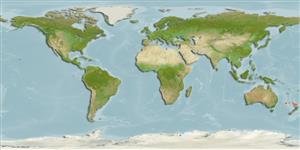>
Gadiformes (Cods) >
Macrouridae (Grenadiers or rattails)
Etymology: Coelorinchus: Greek, koilos = a hollow + Greek, rhyngchos = jaw (Ref. 45335).
Environment: milieu / climate zone / depth range / distribution range
Écologie
marin bathydémersal; profondeur 606 - 975 m (Ref. 26363). Deep-water; 33°S - 37°S
Southwest Pacific: endemic to New Zealand.
Taille / Poids / Âge
Maturity: Lm ? range ? - ? cm
Max length : 82.8 cm TL mâle / non sexé; (Ref. 26363)
Description synthétique
Morphologie | Morphométrie
Épines dorsales (Total): 2. Lips of upper and lower jaws very darkly pigmented; a series of about five (indistinct posteriorly) brownish black saddle marks on the dorsal surface of the body, the first broad, starting before the first dorsal fin origin, the third smaller and paler than the others when viewed dorsally; ventral light organ small, lacking a dermal window; ventral surface of head and lower jaw almost entirely covered with small, heavily spinulated scales; snout moderately long 45.4-51.7% HL; mouth large, with upper jaw 26.0-33.3% HL; suborbital ridge not supported by continuous bone; buccal cavity black; fins pale dusky except for anal fin which has black pigmentation distally along anterior four-fifths (Ref. 26363).
Appears to form small schools (Ref. 26363).
Life cycle and mating behavior
Maturité | Reproduction | Frai | Œufs | Fécondité | Larves
Iwamoto, T. and N.R. Merrett, 1997. Pisces Gadiformes: Taxonomy of grenadiers of the New Caledonian region, southwest Pacific. Mem. Mus. Natl. Hist. Nat. (176):473-570. (Ref. 35908)
Statut dans la liste rouge de l'IUCN (Ref. 130435)
Menace pour l'homme
Harmless
Utilisations par l'homme
Plus d'informations
Noms communsSynonymesMétabolismePrédateursÉcotoxicologieReproductionMaturitéFraiRassemblement de ponteFéconditéŒufsDéveloppement de l'œuf
Taille/ÂgeCroissanceLongueur-poidsLongueur-longueurFréquences de longueursMorphométrieMorphologieLarvesDynamique des populations larvairesRecrutementAbondanceBRUVS
RéférencesAquacultureProfil d'aquacultureSouchesGénétiqueElectrophoresesHéritabilitéPathologiesTraitementNutrientsMass conversion
CollaborateursImagesStamps, Coins Misc.SonsCiguateraVitesseType de nageSurface branchialeOtolithesCerveauxVision
Outils
Articles particuliers
Télécharger en XML
Sources Internet
Estimates based on models
Preferred temperature (Ref.
123201): 5.7 - 8.2, mean 6.6 °C (based on 14 cells).
Phylogenetic diversity index (Ref.
82804): PD
50 = 0.5000 [Uniqueness, from 0.5 = low to 2.0 = high].
Bayesian length-weight: a=0.00102 (0.00046 - 0.00225), b=3.06 (2.88 - 3.24), in cm total length, based on all LWR estimates for this body shape (Ref.
93245).
Niveau trophique (Ref.
69278): 3.7 ±0.5 se; based on size and trophs of closest relatives
Résilience (Ref.
120179): Très faible, temps minimum de doublement de population supérieur à 14 ans (Preliminary K or Fecundity.).
Fishing Vulnerability (Ref.
59153): Moderate to high vulnerability (53 of 100).
